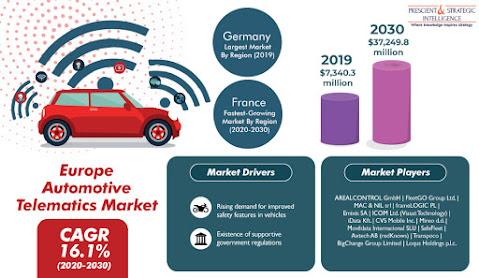Recente Updates
- Saudi Arabia HVAC Market To Touch About $4,822 million by 2030
The size of the Saudi Arabia HVAC market was over $2,390 million in the year 2021, and it will grow at a rate of over 8% in the coming years to reach a value of about $4,822 million by 2030. The industry is mostly driven by snowballing infra spending, the necessity to lessen food wastage, and the increasing hospitality sector.
Saudi Arabia HVAC Market Research Report@ https://www.psmarketresearch.com/market-analysis/saudi-arabia-hvac-market
The increasing acceptance of ground-source HVAC systems will dig out numerous prospects in Saudi Arabia. These systems make use of environment-friendly approaches to heat and cool abodes, using the energy stowed in the ground, thus conserving natural resources like coal and fuel, for electricity generation at power plants. These geothermic systems also help to save a lot of energy.
Also, these systems do not release carbon monoxide or other GHG gases, which further adds to air pollution. As the government of the nation heartens energy-efficient products, these systems contemporary an attractive potential for players in the Saudi Arabia HVAC market.
In 2021, the commercial HVAC systems have the largest demand, of over 40%. The government of Saudi is providing substantial support to the corporate and hospitality sector with the purpose of minimizing its reliance on the trade of oil. Consequently, with the growing count of hotels, resorts, and offices, the commercial sector's demand for this equipment and services is growing. Infra investments by the private and government parties increase the demand for these systems.
For instance, projects like the $26.6-billion expansion of Mecca's Grand Mosque and the $16.5-billion Haramein high-speed rail linking Mecca and Medina are underway. These expansions are intended to increase religious tourism in the nation, with 25 million visitors will visit the holy places every year by 2025. Therefore, rising infra developments in the commercial sector will be a major driver for the growth of demand in the kingdom.
The strong demand for new equipment in the nation is because of its harsh climate. Also, the incessant rise in the count of commercial spaces and other construction projects is pushing up the sales for HVAC systems. For example, the Qiddiya project in Riyadh started in 2019 and will be finalized in 2022.
This project, which is about 45 km from Riyadh, will become the "capital of entertainment, arts, and sports." It has already got a funding of $8 billion and plans to host 17 million visitors annually by 2035. More projects are scheduled in the future as part of the nation's economic zone development plans.
0 0 Reacties 0 Aandelen - Efficiency Elevated: Exploring Qatar's Facility Management Market
In the dynamic landscape of Qatar's thriving economy, facility management has arisen as a vital feature of guaranteeing effective processes and upholding high values in numerous industries.
Qatar Facility Management Market Research Report@ https://www.psmarketresearch.com/market-analysis/qatar-facility-management-market
Facilities management can be defined as the tools and services that support the functionality, safety, and sustainability of buildings, grounds, infrastructure, and real estate. Facilities management includes Lease management, including lease administration and accounting. Capital project planning and management.
The Qatar facility management market is experiencing growth and is projected to reach USD 22,268.2 million by 2030.
Developing Infrastructure Demands
The nation's fast growth and striving infrastructure projects, like the FIFA World Cup 2022 arrangements and the Qatar National Vision 2030, have positioned significant demands on the nations-built environment. Facility management plays an important role in supervising and upholding the infrastructure, transportation systems, stadiums, commercial buildings, and hotels, to guarantee they work optimally and fulfill international standards. By offering complete maintenance, safety, and sustainability facilities, facility management businesses aid in creating a unified experience for inhabitants, visitors, and businesses alike.
Facilities management functions
The title of facilities manager can mean various things depending on the size of an organization and what industry they serve. Their job responsibilities can also be fulfilled by people with different job titles (director of facilities, director of operations, maintenance manager, property manager, and many others).
The easiest way to understand the role of a facilities manager is to break down the facility management services into two categories, hard services, and soft services.
All organizations exist to fulfill a core function, from generating profits to serving a community’s needs. Facilities management is the essential spine of any successful organization.
0 0 Reacties 0 Aandelen - India Industrial Aerosol Market was Dominated by the Engine Cleaners
The India industrial aerosol market will power at a compound annual growth rate of 5.6% in the future, and will reach USD 115.85 million by 2030.
The main reasons, which are accountable for the development of the industry are the increasing requirement for aerosols in vehicle factories and the aftermarket, escalating Indian manufacturing sector, and growing count of initiatives of the government for R&D in the manufacturing industry of India.
India Industrial Aerosol Market Research Report@ https://www.psmarketresearch.com/market-analysis/india-industrial-aerosol-market
Spray paints dominated the industry, and it will continue like this in the years to come. This would chiefly be as a result of the increasing buying power of the Indian people, leading to the increasing requirement for aerosol-based spray paints in the increasing automotive aftermarket and manufacturing plants.
Engine cleaners dominated the India industrial aerosol market, on the basis of type, under the cleaning category. This is chiefly credited to the increasing requirement for aerosol-based engine cleaners for the contamination prevention of the fuel system of the engine.
Furthermore, engine cleaners aid in improving the performance of fuel by decreasing the consumption of fuel and extreme smoke.
The silicone aerosol products had the largest volume share and it will grow the fastest in the years to come. This is mostly credited to the heavy consumption of silicone aerosol products as a result of their resistance to corrosion, lubrication, and easy mold releasing possessions.
As per the IBEF, the Indian manufacturing sector is growing significantly as a result of the increasing requirement for consumer devices, electronic appliances along with electrical apparatus and machinery.
Furthermore, as per the Ministry of Commerce and Industry, considerable growth is there in the recent past in the cosmetics and beauty products industry as a result of the increasing income of people, which is subsequent in a higher personal expenditure. This, is having an enormous influence on the market.
The requirement for aerosols is on the rise unceasingly with the increasing manufacture and sales of passenger cars, three-wheelers, two-wheelers, commercial vehicles, and quadracycles.
As per the SIAM, in 2018–19, India formed 30,915,420 automobiles, which was 6.3% higher than the production of the previous years of 29,094,447 vehicles.
0 0 Reacties 0 Aandelen - What are the Key Applications and Use Cases for Automotive Radar in the Market?
Indian End-of-Life Vehicle and Dismantling Market Research Report@ https://www.psmarketresearch.com/market-analysis/indian-end-of-life-vehicle-and-dismantling-market
Vehicles equipped with advanced driver-assistance systems (ADAS) require large number of radars, as these enable numerous automobile features. ADAS features like eye-tracking, virtual assistance, gesture recognition, natural language interface, virtual assistance, and speech recognition are extensively dependent on advanced radar systems.
Moreover, future developments in ADAS technology will propel the installation of radar-enabled detection units in the vehicles. Owing to this reason, the automotive radar market will progress at a CAGR of 8.4% during 2020–2030. According to P&S Intelligence, the market generated revenue of $5,839.0 million in 2019.
Moreover, surging deployment of long-range radars (LRRs) will supplement the market growth in the forecast period. LRR equipped automobiles can detect other vehicles and other foreign objects in their path, which are up to 150 meters away. This range is extremely wider than short- and medium-range radars. Hence, the improving object detection capabilities of LRRs are increasing their adoption in autonomous vehicles, as they assist in enhancing the safety features of the automobiles. In addition to safety features, the installation of LRRs offers comfort to the drivers while on road.
0 0 Reacties 0 Aandelen - India E-Rickshaw and On-Demand Ride Hailing Market - In-Depth Analysis of Industry Sizing and Dynamics till 2030
India E-Rickshaw and On-Demand Ride Hailing Market is Driven by the Increasing Need for Public Transportation for First-and Last-Mile Connectivity
India E-Rickshaw and On-Demand Ride Hailing Market Growth Report@ https://www.psmarketresearch.com/market-analysis/indian-e-rickshaw-on-demand-ride-hailing-industry
As per a report by a market research institution, P&S Intelligence, the India e-rickshaw and on-demand ride hailing market is expected to reach more than 4 million units on the road, propelling at a 10.8% compound annual growth rate, by 2030.
In the early 2010s, E-rickshaws became increasingly popular in India as they began operating in the suburban and urban regions of Delhi-NCR, as well as towns in Bihar, West Bengal, and Uttar Pradesh. These electric-powered vehicles serve as zero tailpipe emission alternatives, providing first-/last-mile connectivity within these cities.
Moreover, the majority of e-rickshaw services in these areas were initially introduced without proper planning or as pilot projects and subsequently expanded in an unplanned manner.
The increasing pollution level in numerous cities of India, which is a serious concern for people and the government, increases the requirement for green-technology-powered automobiles for traveling.
Presently, India boasts a fleet of over one million e-rickshaws in active operation. Over the last decade, Delhi emerged as the primary industry for e-rickshaws.
A key trend observed in the India e-rickshaw and on-demand ride-hailing market is the growing collaboration between government authorities and public bodies. With the Government of India (GOI) and state authorities taking steps to regulate the use of e-rickshaws, several initiatives are being implemented through public-private partnership arrangements.
One of the primary obstacles faced by all e-rickshaw operators in India is the unavailability and inaccessibility of charging infrastructure. This challenge significantly hampers their mobility during extended working hours and longer trips.
Furthermore, it typically takes 7-10 hours to fully charge a battery to achieve an operational range of 80-110 km, which can vary depending on the battery's load and age. The absence of regulated and fast-charging stations poses a significant challenge for drivers. As a result, they are compelled to rely on services provided by unorganized players.
0 0 Reacties 0 Aandelen - How Does Self-Cleaning Technology Expands Titanium Dioxide Industry?
The titanium dioxide market is projected to rise in the coming years, with the domination of the paints and coatings application, attributed to massive consumption of these products in numerous architectural applications. Moreover, the high requirement for the compound in paints and coatings is led by their high refractive index, non-toxic, and inert nature, along with the capability of absorbing ultraviolet rays.
Titanium dioxide Market Research Report@ https://www.psmarketresearch.com/market-analysis/titanium-dioxide-market
The surge in the paints & coatings in the titanium dioxide industry is led by the massive usage of the compound in them during their application on wall exteriors in both tropical and warm climates, led by the titanium dioxide’s ability to impart whiteness and light reflecting qualities, resulting in energy savings by reducing air conditioning requirement.
The sulfate holds a substantial share of the titanium dioxide market, ascribed to compound extraction from all the ores, such as rutile, titania slag, and ilmenite facilitated by the sulfate process, unlike the chloride process that enables the extraction of titanium dioxide only from rutile ores.
In addition, the technology involved in the sulfate process is mature and simple, and the devices used are easy to use, and possess higher resistance to corrosion, ascribed to such advantages, the sulfate process is projected to dominate in the coming years.
APAC generates significant sales revenue to the titanium dioxide industry, led by rapid urbanization, caused by population explosion, including penetration of key players and expansion of the construction industry in the region.
In addition, the rise in the infrastructure development activities in the emerging economies propels industry expansion, it includes the construction of offices, retail centers, apartments, hotels, offices, and civic infrastructure. It offers alluring opportunities for paints and coatings manufacturing companies to expand their business, led by opacity, ultra-white color, opacity, and high UV resistance, with the growing requirement of the paints and coatings, resulting in the rising growth of the titanium dioxide industry.
Moreover, the massive usage of the compound in various sectors, including plastics, cosmetics, inks, and paper offers plenty of opportunities for the manufacturing companies of titanium dioxide producers. China captures a significant share of the regional industry of the APAC, led by the titania’s high domestic production to cater to the country’s demand for paints and coatings.
0 0 Reacties 0 Aandelen - Transforming In-Car Experience: The Automotive HMI Market Landscape
HMI Advancing the Driving Experience
Nowadays contemporary vehicles are fortified with different types of Human-Machine Interface technologies. Novelty in HMI software and improved UI/UX have augmented its demand in the automotive industry.
Human Machine interfaces in the automotive setting are combined in every thinkable touch point and support drivers and passengers to control infotainment and ADAS applications.
A leading automotive tier 1 supplier desired to advance the driving experience with an urbane human-machine interface based on the GENIVI platform and QT-based Infotainment Head Unit. The customer desires multiple applications like Connected Home, Browser, Navigation, HVAC, and Smart Reverse Parking Assistance fixed in the vehicle infotainment system.
The global automotive human–machine interface (HMI) market is witnessing growth and is projected to reach USD 55,318.4 million by 2030.
Augmented Reality Offers Extraordinary Driver Protection
Merging in-car sensors with a progressive human-machine interface platform will be able to offer the driver a real-time amplified reality experience through a head-up display. The HUD can offer visual data like upcoming cornering strategies, speed limit changes, and even support to imagine the potential movement of other road operators. This lets the driver concentrate on the road without the requirement for added dashboard displays or buttons and surges the total driver and car safety.
Automotive HMI Market Research Report@ https://www.psmarketresearch.com/market-analysis/automotive-hmi-market
Here are Just Some Extents to Where HMI Can Be Appreciated:
Supports Drivers in Making Better Decisions
Human-machine interfaces can offer real-time info to the operator in a simple-to-understand manner. Take electric vehicles, for instance. A driver may be allowed to see just how much power was utilized in real-time based on how hard they accelerated the car.
Can Contribute to a Better Driving Experience
Human-machine interfaces can notify drivers regarding unsafe conditions (i.e., when the car is near the lane limit) and avoid driving crashes (i.e., slow down the vehicle to dodge car accidents).
More Natural Interaction Between the Driver and The Vehicle
Human-machine interfaces can create more natural communication between humans and machinery. For instance, a voice-based system can permit drivers to utilize natural words to give instructions to the car.
Advantages Of Utilizing Digital HMI
Hence, it’s much simpler to fit in a display in a cockpit and update the software once you see whether something works or doesn’t work for your drivers (like mobile phones) rather than design a set of physical controls and have to redesign it entirely if anything went wrong.
0 0 Reacties 0 Aandelen - Europe Automotive Telematics Market was Led by Germany
The Europe automotive telematics market will advance at a rate of 16.1% in the years to come and reach to a value of USD 37,249.8 million by 2030.
Germany Automotive Telematics Market Research Report@ https://www.psmarketresearch.com/market-analysis/germany-automotive-telematics-market
The increasing requirement for enhanced safety features in vehicles, along with the existence of supportive regulations of the government, is the important factor powering the industry, as stated by a market research institution, P&S Intelligence.
The embedded category dominated the industry, based on product type. Also, the category well continues its ascendence in the years to come, mainly as a result of the mandates of the EU to integrate the essential passenger safety solutions in automobiles.
OEMs led the industry based on channel. This will also grow the fastest in the years to come. OEMs are belligerently promoting telematics in low- and medium-end car models naturally greeted by customers.
Passenger cars dominated the industry in the past, based on vehicle type. The high sales of passenger cars, as well as the growing requirement and regulatory mandates for safety features, have brought about to the domination of this category.
Though, the commercial vehicle category will have a considerable share in the years to come. The increasing acceptance of Next-Gen Telematics Protocol for enhancing telematics service delivery and the strict government guidelines for organizing vehicle tracking features in commercial vehicles are promoting the market growth.
Germany dominated the Europe automotive telematics market and the trend will continue to grow in the years to come. Factors including tech progressions and the policies of the government associated with vehicle and passenger safety will boost the requirement for automotive telematics solutions in the nation.
0 0 Reacties 0 Aandelen
Meer Verhalen


